I asked my family to buy me the largest dual-chamber compost tumbler they could find for my birthday. They bought me an EJWOX Large Composting Tumbler, and my sons (12 and 14 at the time) put it together for me.
I love that this large composter has two chambers. We eat a lot of produce each week. It is wonderful to be able to compost the scraps rather than add to the landfills.
The only downsides to a tumbler vs a compost heap for me is that it fills up quickly, especially if you have honeydew, cantaloupe, and watermelon rinds, pineapple, etc. We eat a lot of these each week so I generally am not able to compost the rinds, or I would fill up the tumbler within a month.
If you like the idea of composting, consider a compost tumbler. Composting has many benefits, including reducing waste and producing rich, nutrient-dense organic material (“compost”) to enhance your soil.
Compost tumblers are:
- Easy to use
- Easy to rotate
- Low maintenance
- No smell
- Won’t attract critters
- All contained; no mess
Here I answer some of the most popular questions about easy-turning compost barrels, what tumble composting is, how to use a compost tumbler, and how long it takes to compost — aka make black gold.
I also include a list of compost tumbler pros and cons. You can use this list to consider if getting a compost tumbler is for you and your situation. If you know you want to start composting, you can use this info to decide between getting a compost tumbler vs starting a compost pile.
Compost Tumbler
Overall, I think compost tumblers are terrific, but depending on your circumstances, you may not need one. The people who will benefit most from compost tumblers are those who:
- Don’t want to have to manually turn over their compost
- Have limited outdoor space for a pile
- Don’t have a lot of yard debris
- Want an easy way to compost without much maintenance
- Want to compost in an enclosed space
If you have limited space in your garden or live with neighbors close by, you’ll also see more benefits from how tidier and more odorless they are. Also, consider the pests and wildlife in your area. A closed compost system will not attract them in the same way an exposed compost pile may.
What Is a Compost Tumbler?
To put it simply, a compost tumbler is a sealed container, such as a barrel you can rotate or tumble. The two main differences between a compost tumbler and a compost heap or pile are:
- A compost tumbler is sealed so it generates heat more quickly, speeding up the composting process
- The tumbler can rotate, which means that you can mix its contents more easily
- As you turn the decaying materials, you are aerating them
Owning a tumbler is very convenient for people who are new to composting. Simply slide open the compost door and toss in your kitchen scraps and yard waste. They are also ideal for people without a lot of outdoor space and who don’t want to attract pests.
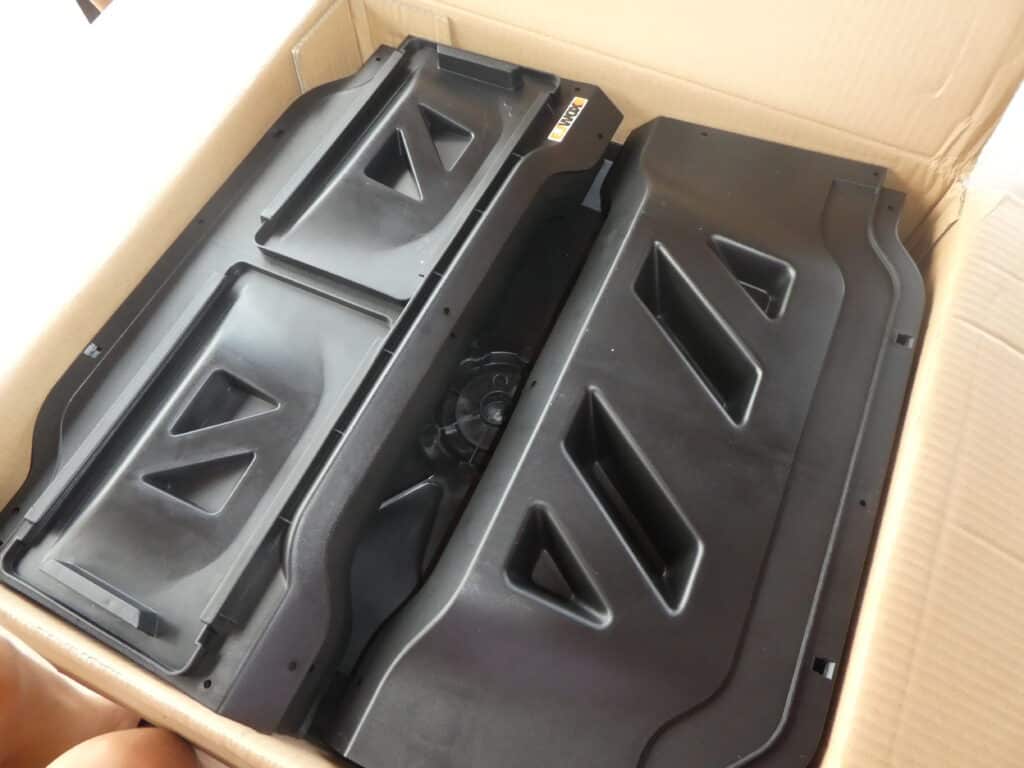
Are Compost Tumblers Any Good?
Before buying one, it’s natural to wonder if compost tumblers are any good and if they’re worth the money. To some people, they can’t compost without them, but it depends on your abilities and situation as to whether you need one.
A compost tumbler will generate and hold heat more effectively than an open composter drum, heap or pile will. This is because it’s all enclosed.
What I love about them the most, though, is that you can mix the compost more easily. You simply turn the handle to turn the drum over. It is a fantastic selling point for people who may struggle to turn a compost heap every few days. It literally takes seconds to rotate the tumbler.
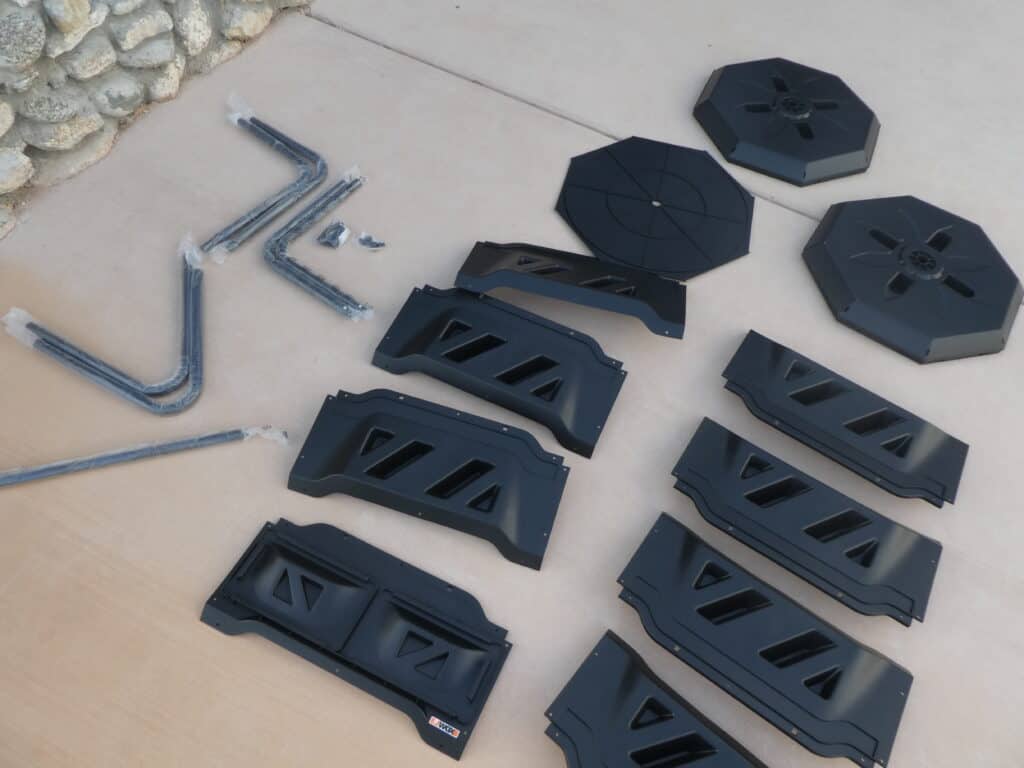
In addition, there is minimal smell when you use a compost tumbler. This also means you won’t attract pests and wildlife like you might when starting a compost pile. Animals won’t be able to access the food and composting materials.
What’s also great is they are often on wheels. This means you can move them around as needed. You may want to roll it to your garden when you are taking out the compost but keep it closer to your home to fill with kitchen scraps.
Compost tumblers are ideal for households without a section on your property to compost. They are compact and can fit on a patio or balcony. Consider how much compost you want to produce and how big of a space you have for the tumbler.
One of the biggest drawbacks to owning a compost tumbler is if you have a lot of garden waste, such as grass clippings, etc., to compost. You won’t be able to fit a lot in the tumbler. I think it’s more suited for people with fruit and vegetable scraps, and some paper and cardboard but not large amounts of yard debris.
How Do You Make Compost in a Compost Tumbler?
Compost is really easy to make, no matter how you’re making it or what you’re making it in. You just need to learn what kinds of things you can compost, and then follow the tumble composting procedure below.

Three Easy Steps to How a Compost Tumbler Works
To start composting in a tumbler, here are the things you need to do:
1. Fill the tumbler with scraps and more
Open up the compost tumbler and add all of your brown and green waste from both your garden and kitchen. Pay attention to the proper ratio of greens to browns at a ratio of 2:1 so it’s balanced. You may need to add organic matter from your yard or other sources to make it balanced.
It’s also important to know the difference between greens and browns. As an example, freshly cut grass clippings from your yard are counted as green in composting. However, if left in a pile to dry, they are considered brown matter in composting.
We keep a bale of alfalfa to add to our compost as a brown as we tend to have a lot of vegetable scraps each day. In this way, we can also use the alfalfa as mulch for the gardens.
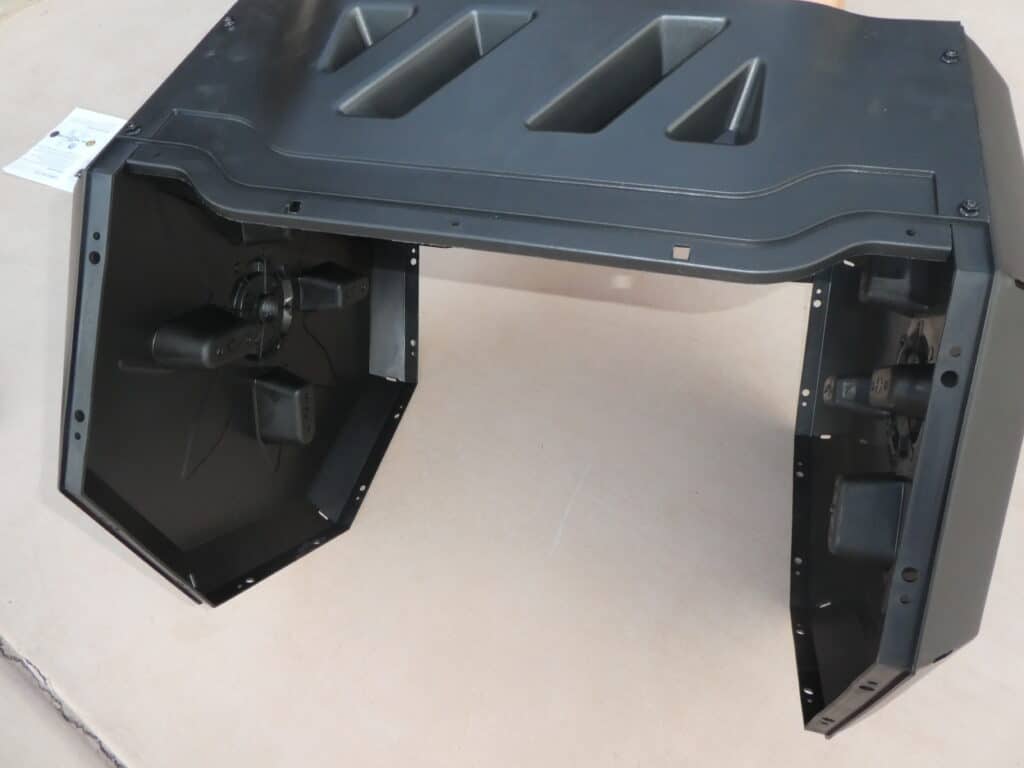
Once your tumbler is full, make sure you close the lid properly. Then, you just need to give it time to get to work. The organic materials will start breaking down inside the tumbler producing heat.
You can save up scraps from fruits and vegetables, egg shells, coffee grounds, and more. Some people keep them in a container on their kitchen counter for a day or two before putting it in the composter. You can move the composter around to make it convenient to access.
2. Turn the Tumbler
At least once a week, roll or turn your tumbler to mix up all of the contents inside. Most compost tumbler models feature a crank or handle to make it easy. Rotating the compost bin aerates the compost.
Unlike when you have a compost pile where you need to physically turn over the composting materials with a shovel or rake, with a tumbler, you simply turn the handle. You can roll it and know everything inside is properly turned. When you have a pile, especially a deep one, it becomes difficult to do this by hand.
When composting, the mixing process infuses the mixture with fresh, heat-producing oxygen, which is vital to the composting process.
3. Use the Compost
When your compost is ready, you can access it easily by opening the door or hatch and letting it fall into a bucket, ready for spreading into your garden or pots and planters. You can also take out scoopfuls as you need to add to some plants, especially midway through their producing season. We do this with our okra in order to give it a boost.
The advantage of a compost tumbler is you can wheel it to wherever you need. Most composters come with wheels which make it easy to roll.
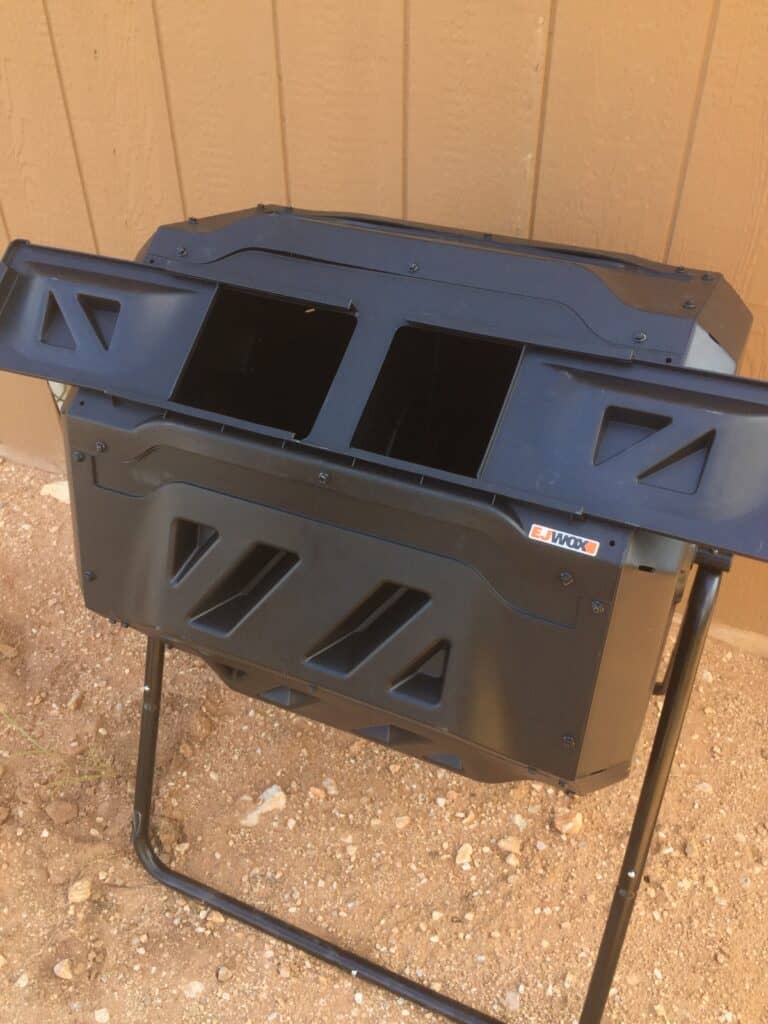
How Long Does It Take to Compost in a Tumbler?
It can take as little as five to six weeks for a compost tumbler to turn out the compost. Several factors will affect the composting process’ speed, such as moisture, air, heat, and compost starter.
1. Moisture Level
Ideally, your compost shouldn’t be too wet or too dry, but just moist. Usually there is already enough moisture in the items you compost, such as kitchen scraps and grass cuttings, to maintain optimum moisture levels.
As such, you should try to avoid adding water since it will cool and slow the composting process down. If you live in a very dry environment, it may be necessary. You can add to it once a week. However, in general, add as little water as possible. Keep your balance of greens to browns and add what you need.
Personal note: I live in the hot and dry southwestern United States. I have to add water once a week or the materials won’t decay and decompose. They simple dry out.
2. Air
Your compost tumbler will ideally be well ventilated with small air holes since a constant source of fresh air is needed to keep the composting process going. There is nothing you need to do to “give it air.”
You will need to turn or mix your compost bin once a week to ensure fresh air permeates through the mixture. In most cases, a compost tumbler is easier to aerate than a compost barrel or composter drum because it turns. It’s designed so it’s easy to turn with minimal effort, no matter how filled and heavy it is.
With stationary composters, you would need to get a fork or another device inside to turn the compost over manually.
3. Heat
If you’re feeding your compost tumbler a good mix of nitrogen and carbon materials, it will generate a lot of heat. The compost tumbler will help to keep the heat in, but you will notice that the composting process takes longer in colder months.
If you notice the temperature dropping, you can heat it back up again by adding more nitrogen-rich materials and turning it more. Also, if you live in an area with consistently hot summers, you may want to put the composter in the shade.
4. Compost Starter
You can add a compost starter to your waste to help kick-start the process, although it is not actually needed to make compost. Once you’re making compost regularly, you can just keep a little compost from the previous batch to use as a starter.
You can also add some soil from the garden to get the composting process going.
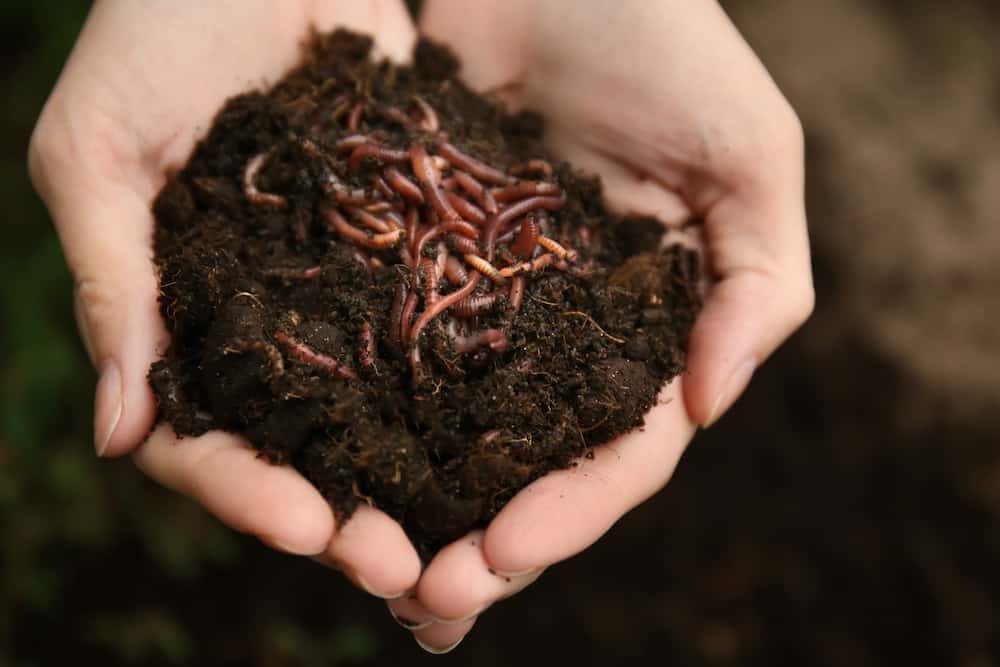
Can You Add Worms to a Compost Tumbler?
I don’t recommend adding worms to a compost tumbler because the conditions need to be ideal for worms. However, in theory, yes, you can add worms to your compost tumbler, but you should be careful to ensure you add them at the right time.
If you place them into fresh waste, then there won’t be anything for them to eat. You need to wait for the waste to rot to a point where worms will see it as food.
You also need to consider the climate in which you live. Adding worms to a compost tumbler is different than adding them to a compost heap. In a tumbler, they are trapped, so to speak. They have nowhere to go and are subject to the conditions inside.
Being there is no way for the worms to escape, they will die when the temperature starts to rise. Therefore, if you’re worried about worms not thriving, then you probably shouldn’t add worms to your compost tumbler.
I live in USDA hardiness zone 9b which is a dry climate. I do not add them to my compost bin. It’s just too hot most of the year. While I don’t have worms in our compost tumbler, I have encouraged them when we had a big compost pile that was in the back of our property in some shade. Worms enrich organic matter but aren’t as suited for a compost tumbler as they are for a compost pile.
Also note, worms don’t like citrus, onions, leeks, or garlic. This means, if you add worms to a compost tumbler, don’t use scraps from lemons, limes, oranges, grapefruits, etc. In a compost pile, it’s not as much of an issue because worms can go elsewhere. In a tumbler, there’s nowhere else for them to go.
Adding Worms to a Compost Tumbler
If you are prepared to care for them, you can add worms to a compost tumbler. For me, the best part of owning a tumbler is that it takes minimal effort. I like tossing scraps in and rotating it. I add water from time to time. That’s it. With worms, you will need to put in some work.
Don’t add earthworms from your garden; they are not suitable for composting. You will also have to work to maintain proper moisture levels. In certain climates, like where I am in the dry southwestern United States, this is very important year round. My compost materials dry out if I don’t water them regularly, despite how wet the fruit and veggie scraps are.
If you want to add worms, add red worms (Eisenia fetida). They are known as red wigglers or composting worms. They are the best worms for compost tumblers to help the decomposition along. They consume the organic materials and help break them down. Then the worms excrete nutrient-rich castings. This greatly enhances the compost quality.
How to Add Worms to a Compost Tumbler
- Choose red worms: They are voracious eaters, and thrive in decomposing organic matter. Don’t use earthworms!
- Provide moisture: In order to survive, worms need a moist and aerated environment. Ensure your compost tumbler provides enough moisture and ventilation.
- Add bedding material: Add shredded newspaper or cardboard to provide a comfortable habitat.
- Add food waste in moderation: Worms require a balanced diet. Introduce small amounts of kitchen scraps, fruit and vegetable peels, coffee grounds, tea leaves, and crushed eggshells. No onions, garlic, leeks, and citrus fruits and peels; worms do not like them.
- Monitor temperature: Compost tumblers can generate heat during the decomposition process. Ensure that the temperature remains within the suitable range for the worms, typically between 55°F (13°C) and 77°F (25°C). Place the tumbler in the shade in warmer months. Keep the compost moist (but not waterlogged) to provide a conducive environment for the worms.
- Time your scraps: It’s important to not overload the tumbler. Worms require enough space to move around and access oxygen. Gradually add new material as the worms process the existing compost.
Worms in a compost tumbler work best when the system is well-maintained. It’s essential to regularly monitor the moisture level, temperature, and the worms’ overall health.
Providing them with the right conditions and appropriate food, they will efficiently transform your organic waste into nutrient-rich compost faster than composting without worms.
Like with all home composting, you should avoid adding meat, dairy, and oily foods. These create an unfavorable environment for the worms.
Worm Farm – Should You Start One?
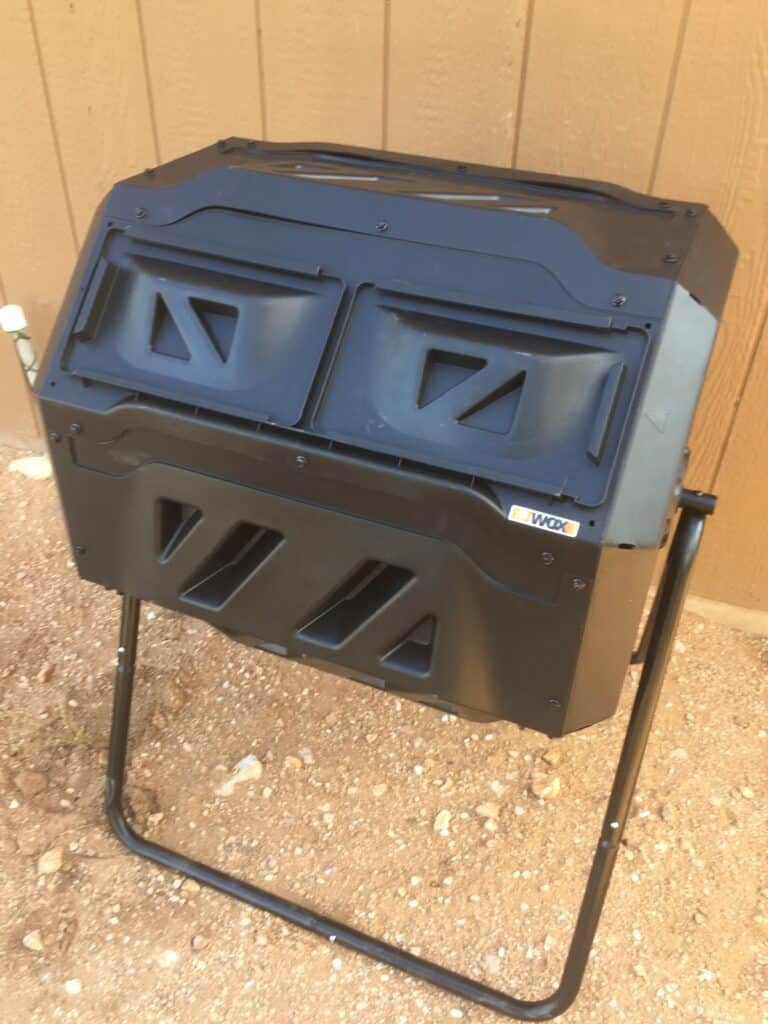
Compost Tumbler: Pros and Cons
Now that I’ve explained how a compost tumbler works, I want to revisit the pros and cons in more depth.
Pros of Compost Tumblers
Some of the main benefits that people who use compost tumblers enjoy include:
1. Turnability / Mixes Easily / Easy to Use
There’s no denying that a compost tumbler generally makes lighter work of turning and aerating the composting mixture. Whether they work by turning a crank or simply roll around a central rod, as long as they’re not too big, they’re effortless to mix.
2. Save Time
You will save time using a tumbler versus turning over a compost pile. It takes more time and energy to turn over a compost heap or mix a compost barrel with a fork or other device.
3. Less Physical than Manually Aerating the Materials
It’s also way less physical work to rotate a compost tumbler than it is to rake and turn over mounds of decaying materials in your yard. You won’t have to work as hard as you would with manually turning compost with a traditional compost pile. This means less wear and tear on your body.
4. Faster Composting
If ideal conditions are present, the composting process can be completed more quickly in a compost tumbler. With the right moisture levels, outdoor temperature, and balance of carbon and nitrogen waste, you can compost in just five weeks.
It’s smaller than an ever-growing pile so it will cure faster. In addition, if you buy a composting bin with two chambers, you can fill one and let it finish composting. You won’t be adding to it like you would with a compost pile. Instead, you add your veggie scraps to the the second chamber.
5. It’s Enclosed So No Critters Can Get It
You can do your best to keep wildlife out of a compost heap, but they usually will find a way to it. They will be attracted to the smell, and then stay to enjoy eating it. This can include rats and mice.
If you have a compost barrel on the floor, they often don’t have a bottom, which is excellent for worm access. However, it does also mean that small rodents, raccoons, and pests can burrow their way into your compost.
When you own a compost tumbler, it’s sealed except for small air holes for ventilation. You won’t have animals in it. You may attract some insects such as ants or gnats from time to time, but it should be minimal.
In addition, compost tumblers are generally raised above the ground, making it more difficult for rodents and pests to access it.
6. Attractive
A compost tumbler is a more attractive option than a compost bin, but especially a heap. They usually have sleek designs and offer a very tidy operation overall, keeping your garden looking clean and attractive. This may be important if you don’t have a lot of land and will see it from your home, or if you live in a neighborhood setting.
7. Produce Little to No Odor
The sealed design of a compost tumbler also makes them less smelly, a must for properties with smaller gardens. No doubt your nearby neighbors will appreciate it too! When you keep the ratio of greens to browns in check, it shouldn’t smell.
8. Can Be Portable
You may want to choose a rolling composter with wheels if you wish you move it around your property. Rolling composters are convenient and enable you to bring the finished compost to your garden. This means you can leave your tumbler where it’s convenient for you to add scraps to it as well as roll it to wherever you want to use the compost. When it’s convenient, you will be more apt to want to make compost.
Side note: My composter doesn’t have wheels and I don’t miss it. I’m glad to have a large compost tumbler — it’s 43 gallons. I’d rather have the ability to make more compost than move it around easily.
9. You Know When the Compost is Finished
With a pile you keep adding to, it may be difficult to know what stages the materials are in the decomposing process. With two chambers, it’s much easier to know because they are completely separated.
10. Fairly Easy to Access the Finished Compost
The doors on my compost tumbler slide off easily which makes it easy to scoop out the finished organic compost matter. I scoop it out with a garden shovel and put it in a bucket. You could also turn the tumbler so the hole opens into a large container and dump out the compost that way.
11. Small Footprint
Compost tumblers are ideal for people who don’t have a lot of outdoor space. They don’t take a lot of space.
Cons of Compost Tumblers
When I drew up our list of limitations of the compost tumbler, I found it to be the shorter list of the two and includes:
1. Costs Money
While you can begin a composting pile or heap in your yard for free, you will have to buy a compost tumbler. There are different sizes of compost tumblers. Some are smaller and less expensive than larger compost tumblers. Still, you can get a decent one for less than $100. These are ideal for families.
The great news is there isn’t anything else you need to buy after you get the compost tumbler. Everything you put into it is recycled waste. The tumbler itself is a one-time purchase.
2. You Have to Put the Composter Together
If you make a DIY compost tumbler or buy one from a home improvement store or hardware store, you will need to put it together. The compost tumbler we bought was easy to put together. (I had my preteen and teen build it for me! They are good at tinkering and built it in less than an hour.)
With a compost pile, there isn’t anything to build. You may want to define the space with concrete blocks or bricks, but there is nothing you HAVE to do when you start a pile.
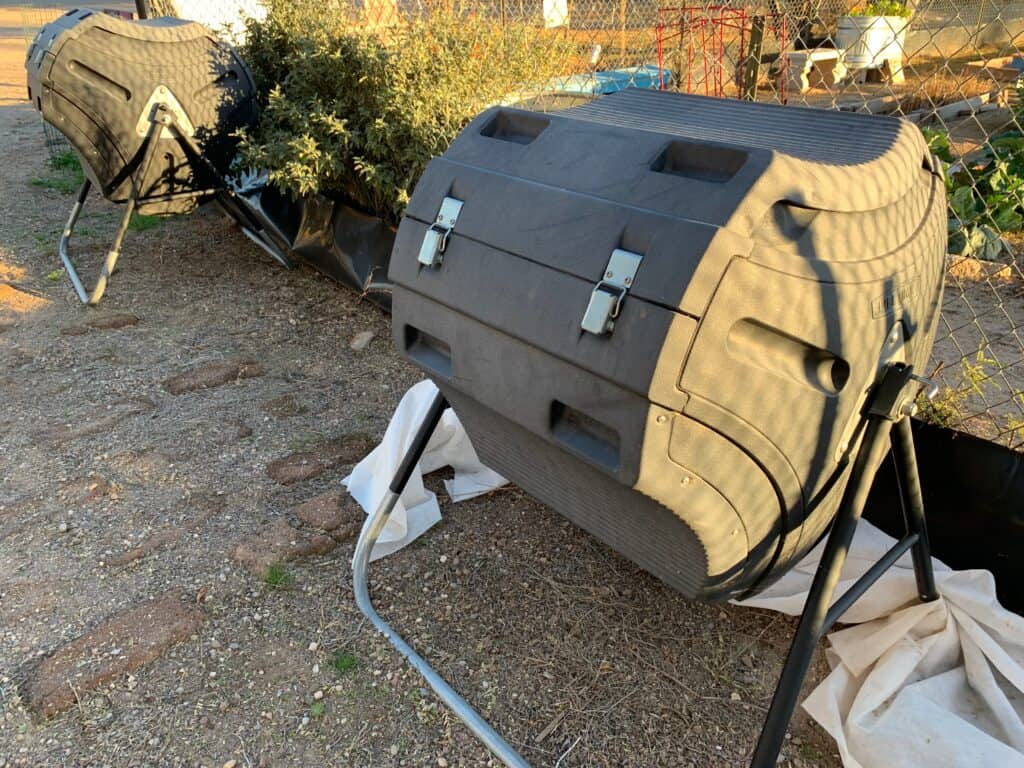
3. It Fills Up
If you live on property in which you will have a lot of yard waste, a compost tumbler will not be ideal. It will fill up quickly. Consider having an open compost heap or compost pile for your brown material (dried leaves, tree branches, twigs, bark, sawdust, pine needles, etc.) and for your greens (grass clippings, manure from livestock, etc.).
You can add a compost tumbler as well and use it for household compost materials such as kitchen waste, (eggshells, coffee grounds, scraps from fruits and vegetables) egg cartons, cardboard, and newspapers, etc.
It’s important to know, a compost tumbler will fill fast if you are an active family with lots of kitchen scraps and other materials.
Once you fill your compost tumbler with waste, there’s nothing to do but wait. This means, while you are waiting for it to compost, you will have to throw away vegetable and fruit scraps, paper, and more.
You can choose one with multiple chambers in multiple stages of decomposition. I have a compost tumbler with dual chambers. I like it because I can fill one side and let it cure while adding to the second chamber.
Even still, a large, active household can fill up two chambers in several months. You can add a second compost bin to your property and them them all cure in various stages.
With an outdoor compost pile, you can keep adding to it in different sections. This means you won’t be “wasting” produce and yard debris.
4. Worms Don’t Thrive Inside
Worms would have to be added manually to a compost tumbler, and unless they have means of escape, they might die. I really don’t recommend adding worms unless you are experienced.
5. Less Manual Labor
While this may be a good thing for some people, others may like the physical work that manually turning over a compost pile entails. (For me, I consider it one less thing I have to deal with and am happy that it’s less physical labor.
6. Watch For Insects – Sometimes
After you use the composter for a week or so, when you open the sliding door, you will quickly learn to step aside. Depending on where you live and the season, you may have insects flying out. They are small, harmless, and gnat-like but you won’t want them flying in your face.
If you have a compost pile, there will also be insects as well but they won’t come out in full force because the pile is exposed. For me, a few insects is nothing compared to having the manual labor of turning over heavy compost with a heap.
7. Finished Compost
Sometimes the finished compost falls out through the air ventilation holes. For me, this isn’t an issue because mine is on soil on my property. However, if you have the tumbler on a balcony or patio, you may need to sweep it up.
8. You Can Only Make So Much Compost
You can make as much black gold as you have space. In a compost pile, there is no limit to what you can cure and the organic materials you can add. However, in a composter tumbler, it’s a limited space.
I own 43 gallon compost tumbler which fits my household’s needs. We eat a lot of fruits and vegetables and toss in our recyclable papers and cardboard. However, I don’t add in much yard waste because I don’t have room.
Also, a lot of times I don’t add in the tops of pineapple and entire watermelon rinds because I just don’t have the space. With the pineapple tops, it will take a long time to decompose so I don’t toss it in unless it’s toward the beginning of the composting cycle.
Tumbler Composting
Choosing a compost tumbler is a great addition to homesteading. You get to use what you have by not wasting and help to enrich your soil for gardens. It doesn’t take long to produce batches of compost from materials you would have just thrown away. Adding compost to garden beds and containers is an asset and a great way to amend your soil.
It’s environmentally friendly and can save you money in the long run. It also feels good to not waste produce scraps, especially the times my family forgets to eat a fruit or vegetable and it rots. At least it can be composted.
A rotating compost tumbler really is easy to use. Even with larger compost tumblers, their turn-ability isn’t really compromised by the weight of the compost inside. There is a size limit on compost tumblers to ensure that you can turn them, even when they’re full.
Makes it Convenient for Everyone to Compost
Making your own compost helps you use fruits and vegetable scraps, newspapers, cardboard boxes, grass clippings, and leaves. In addition to using them and making compost out of them, you are able to keep them out of the landfills.
Beginning composting is a great first step to homesteading. A composting tumbler lets you live sustainably easier. You can use a compost tumbler in a small space such as a balcony or deck. They are ideal for suburban and urban areas and dwellings as they are compact and not unpleasant to look at.

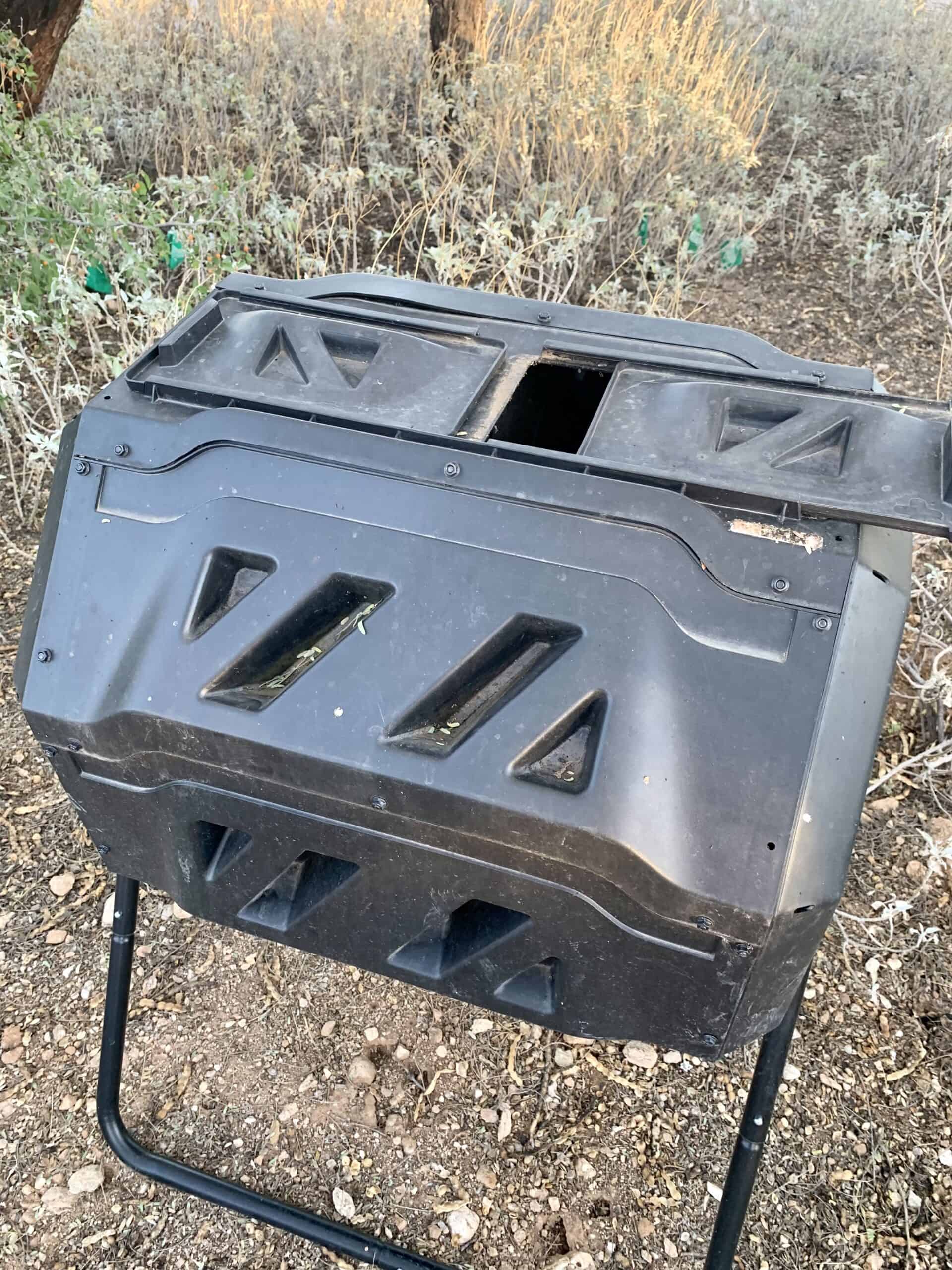
So we have questions , at what point do you stop adding scraps bc at a point you’ll have compost dirt but don’t want to add anymore raw materials. Do you get a 2nd or 3rd tumbler? Then once you have compost dirt, how do you store it? Make your own bags?
Great questions… so glad you asked. It’s always difficult to know when to stop adding scraps to a compost pile. With a compost heap on the ground, it’s good if you have an area to start a newer heap, even if they are just a bit separated within the same area. You may want to consider the temperature/season to know whether to make the first pile bigger (end of winter/beginning of spring) or stop adding to a smaller pile (perhaps late summer, depending on how soon winter comes in your area) so it will have time to cure to use or store in the fall/early winter). If you live in a climate that has mild winters/rarely below freezing where you will still be able to compost, this may not matter as much.
In a compost tumbler, it’s easier to know when to stop adding to it because there comes a point when there’s no room to add scraps or lawn debris. If you have a tumbler that you can turn to rotate, you will know when to stop adding to it because you don’t want it too packed. Air needs to be able to circulate. Having a dual-chamber composter is ideal. You can add to one side while the other side is curing. Once you empty the finished compost, you can start adding to that side to make another round.
Having two compost bins each with dual-chambers would mean you could have four batches in different stages of decomposition which would be awesome. It would be especially helpful if you have a household with a lot of vegetable and fruit scraps and other household and garden compostable materials. It’s frustrating to fill up the compost bin and “waste” kitchen scraps by throwing them in the garbage because you have no room in the composter!
We have a 43 gallon compost tumbler (total capacity) with two chambers, and are considering a second one for this purpose. Just imagine having four sections composting in various stages makes me very happy! We would get another 43 gallon one; the same model we have.
As far as storing finished compost, it is best if you can use it soon after collecting it so it doesn’t lose nutrients by being sealed, not rotated, etc. However, if you have a harsh winter, have extra compost, etc. you may want to save the compost to use for spring plantings.
If you have room in your yard or on your property or even in a garden bed, you can pile the compost there. Cover it with a tarp, use rocks or stakes to keep the tarp secure. This will keep it protected from rain and snow. It will also help to maintain oxygen and humidity levels.
You can also use heavy-duty plastic lawn bags to store finished compost. These can get heavy though so don’t fill them too high. You’ll also need to poke some holes in the bag and try to mix it — even rotating the bag will help mix the compost. Like when you are making compost, you’ll need to consider the humidity and oxygen levels when storing compost in bags. Fabric bags work well too. If you are lucky enough to have an extra composter, you can store it in there as well, especially if you don’t compost in the winter months. You may also consider a smaller garbage can with a lid that has some airflow.